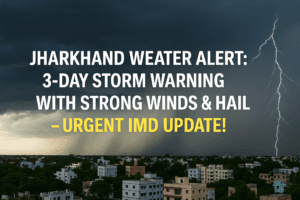Jharkhand Weather Alert: 3-Day Storm Warning With Strong Winds & Hail – Urgent IMD Update!
The India Meteorological Department (IMD) has issued a fresh weather alert for Jharkhand, forecasting thunderstorms, lightning, and strong winds over the next three days starting April 9. Several areas, including Jamshedpur, Ranchi, and Daltonganj, are likely to be affected, with both Yellow and Orange alerts in place depending on the severity. The alert also warns of possible hailstorms in certain districts, especially on the first day of the forecast. Residents are advised to stay indoors during storms, secure loose items, and avoid sheltering under trees during lightning.
The IMD has urged people to remain cautious as the weather could change rapidly. Emergency services are on alert, and local authorities are monitoring the situation closely. The weather change is linked to seasonal atmospheric shifts commonly seen in eastern India during April. People are encouraged to follow official weather updates and take all necessary precautions to stay safe.

Jharkhand Weather Alert: 3-Day Storm Warning With Strong Winds & Hail – Urgent IMD Update!
The India Meteorological Department (IMD) has issued a critical weather advisory for Jharkhand, warning residents of intense thunderstorms, hailstorms, lightning, and strong winds expected to sweep across the state over the next three days, beginning Tuesday, April 9. Multiple districts, including major cities like Jamshedpur, Ranchi, and Daltonganj, have been placed under Yellow and Orange alerts, signaling varying levels of risk due to the anticipated severe conditions.
Understanding the Alerts
The IMD uses a color-coded system to categorize weather warnings. A Yellow alert advises residents to “be aware” of potential adverse weather, while an Orange alert escalates the warning to “be prepared,” indicating a higher likelihood of disruptive conditions. In this case, districts under the Orange alert are expected to face more intense storms, including damaging winds and hail, whereas Yellow alert regions may experience moderate thunderstorms and gusty winds. Authorities are closely tracking the situation and may upgrade alerts if conditions worsen.
Affected Areas and Timing
The IMD’s forecast highlights that the weather disturbance will impact large parts of Jharkhand from April 9 to April 11. On Tuesday (April 9), isolated regions—particularly in northern and central Jharkhand—could witness hailstorms alongside thunderstorms. Cities such as Jamshedpur, Ranchi, Daltonganj, Hazaribagh, and Gumla are among the high-risk zones. Over the following days, the storms are likely to spread eastward, affecting additional areas with heavy rain and wind speeds reaching 40–50 km/h.
Why This Weather Is Occurring
While the IMD has not specified the exact cause of this weather system, such storms are typical during the pre-monsoon months (March–May) in eastern India. Rising temperatures and moisture-laden winds often collide, triggering unstable atmospheric conditions that lead to thunderstorms, lightning, and hail. Climate experts note that these patterns have become more erratic in recent years, possibly linked to broader environmental changes.
Safety Precautions for Residents
State authorities and disaster management teams have urged citizens to prioritize safety. Key recommendations include:
- Avoid open fields and elevated areas during thunderstorms, as lightning strikes pose a serious risk.
- Secure loose outdoor objects like furniture, signage, and construction materials to prevent damage from strong winds.
- Stay indoors as much as possible, especially during peak storm hours. Unplug electronic devices to avoid damage from power surges.
- Farmers are advised to delay outdoor activities and protect livestock, as hail can destroy crops and harm animals.
- Keep emergency kits ready with essentials like flashlights, batteries, and first-aid supplies.
Impact on Daily Life
The impending storms could disrupt travel, damage property, and lead to temporary power outages. Flight and train schedules in affected districts might face delays, while rural areas with weaker infrastructure are at a higher risk of flooding or tree falls. The state government has directed emergency response teams to remain on standby, and hospitals have been alerted to prepare for potential weather-related injuries.
Ongoing Monitoring and Updates
The IMD is continuously analyzing satellite data and weather models to refine its predictions. Local administrations are using SMS alerts, radio broadcasts, and social media to keep communities informed. Residents are encouraged to follow trusted sources like the IMD website or state disaster management portals for real-time updates.
A Call for Community Awareness
Community leaders and local organizations are playing a vital role in spreading awareness, particularly in remote villages where communication channels may be limited. Schools in high-alert zones have been advised to consider temporary closures, and public events scheduled during this period are being postponed.
Final Thoughts
As Jharkhand gears up for this rough weather spell, cooperation between residents and authorities is crucial. By staying vigilant and adhering to safety guidelines, the risks posed by these storms can be minimized. The IMD’s advance warnings provide a valuable window to prepare, and ignoring these alerts could prove dangerous.
Keep your phones charged, avoid unnecessary travel, and check on vulnerable neighbors, especially the elderly. Nature’s fury is unpredictable, but preparedness can make all the difference. Stay safe, Jharkhand!
You must be logged in to post a comment.